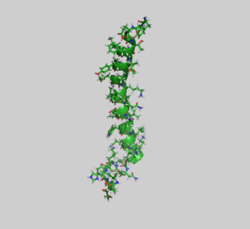| peptide insulinotrope dépendant du glucose |
|---|
 |
|
| Structures disponibles |
|---|
| PDB | Recherche d'orthologue: PDBe RCSB |
|---|
| Identifiants PDB |
|---|
2L71, 2B4N, 2OBU, 2QKH, 2L70, 1T5Q |
|
|
| Identifiants |
|---|
| Aliases | GIP |
|---|
| IDs externes | OMIM: 137240 MGI: 107504 HomoloGene: 3043 GeneCards: GIP |
|---|
| Position du gène (Homme) |
|---|
 | | Chr. | Chromosome 17 humain[1] |
|---|
| | Locus | 17q21.32 | Début | 48,958,554 bp[1] |
|---|
| Fin | 48,968,596 bp[1] |
|---|
|
| Position du gène (Souris) |
|---|
 | | Chr. | Chromosome 11 (souris)[2] |
|---|
| | Locus | 11|11 D | Début | 95,915,371 bp[2] |
|---|
| Fin | 95,921,657 bp[2] |
|---|
|
| Expression génétique |
|---|
| Bgee | | Humain | Souris (orthologue) |
|---|
| Fortement exprimé dans | - muqueuse jéjunale
- duodénum
- pancreatic ductal cell
- stromal cell of endometrium
- nerf sural
- placenta
- foie
- rein
- testicule
- cæcum
|
| | Fortement exprimé dans | - duodénum
- crypt of lieberkuhn of small intestine
- Jéjunum
- Épithélium intestinal
- Villosité intestinale
- épithélium pigmentaire rétinien
- morula
- corneal stroma
- iléon
- spermatide
|
| | Plus de données d'expression de référence |
|
|---|
| BioGPS | |
|---|
|
| Gene Ontology |
|---|
| Fonction moléculaire | - hormone activity
- liaison protéique
- signaling receptor binding
| | Composant cellulaire | - cytoplasme
- endoplasmic reticulum lumen
- région extracellulaire
- neuronal cell body
- secretory granule lumen
- milieu extracellulaire
| | Processus biologique | - response to selenium ion
- response to amino acid
- response to organic cyclic compound
- digestive system development
- regulation of insulin secretion
- adult locomotory behavior
- gestation
- response to peptide hormone
- positive regulation of cAMP-mediated signaling
- mémoire
- response to glucose
- response to lipid
- response to nutrient levels
- positive regulation of synaptic transmission
- Comportement exploratoire
- response to axon injury
- response to starvation
- nociception
- positive regulation of glucagon secretion
- positive regulation of glucose transmembrane transport
- response to carbohydrate
- triglyceride homeostasis
- transduction de signal
- response to acidic pH
- endocrine pancreas development
- positive regulation of insulin secretion
- potentialisation à long terme
- regulation of signaling receptor activity
- G protein-coupled receptor signaling pathway
- regulation of fatty acid biosynthetic process
| | Sources:Amigo / QuickGO |
|
| Orthologues |
|---|
| Espèces | Homme | Souris |
|---|
| Entrez | | |
|---|
| Ensembl | | |
|---|
| UniProt | | |
|---|
| RefSeq (mRNA) | | |
|---|
| RefSeq (protéine) | | |
|---|
| Localisation (UCSC) | Chr 17: 48.96 – 48.97 Mb | Chr 11: 95.92 – 95.92 Mb |
|---|
| Publication PubMed | [3] | [4] |
|---|
|
| Wikidata |
| Voir/Editer Humain | Voir/Editer Souris |
|


 Portail de la biochimie
Portail de la biochimie  Portail de la médecine
Portail de la médecine 

















